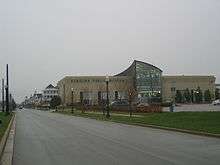Kenosha Public Museum
| A Natural Sciences and Fine and Decorative Arts Museum | |
 Kenosha Public Museum in 2004 | |
| Established | 1933 |
|---|---|
| Location | Kenosha, Wisconsin |
| Coordinates | 42°35′10″N 87°48′47″W / 42.5862°N 87.8131°WCoordinates: 42°35′10″N 87°48′47″W / 42.5862°N 87.8131°W |
| Type | Natural sciences, Fine arts, Decorative arts |
| Collection size | 80,000 (1,200 fine art pieces) |
| Director | Dan Joyce |
| Nearest parking | 230 |
| Website |
www |
The Kenosha Public Museum, in Kenosha, Wisconsin, features displays of fine art, decorative art, and natural science specimens. Founded in 1933, and opened to the public in 1936 [1] the museum currently is located at Kenosha's lakefront. Aside from the collections, the Museum also hosts many classes, changing exhibits, workshops and events throughout the year.
Collections
One major exhibit at the Kenosha Public Museum is The Wisconsin Story, which features the Schaefer mammoth remains and a replica of the Hebior mammoth.[2] The Schaefer mammoth is in the collections of the Kenosha Public Museum along with two other mammoths from Mud Lake and the Fenske site. The Schaefer and Hebior mammoths represents the earliest known interaction between man and mammoth, and were excavated by a team of professional archaeologists from all over the state of Wisconsin during the years 1992-1994.[3] The actual Hebior mammoth remains are in the collection of the Milwaukee Public Museum,[4] however, the Friends of the Museum provided the funds for the Kenosha Public Museum to acquire a replica.[2] The Wisconsin Story exhibit also features Native Americans through time, the coming of Europeans to Wisconsin and a Potawatomi village in four seasons.
Exhibit galleries house changing works of art created by masters, as well as locally-known artists.
Usually, certain wings and galleries do not house permanent collections, but rather display exhibitions such as "Rembrandt: States, Fakes, and Restrikes", an Inuit art display, or traveling exhibitions like "Sustainable Shelter."[2]
History
The Kenosha Public Museum was first located at 5608 10th Avenue, in a one-story Beaux Arts building.[5] This building, designed by James Knox Taylor, was completed between 1908 and 1910. Interestingly, the building was then moved, one foot at a time, across the street to its current location. Originally, the building served as the city's Post Office, but in 1933, it became the Kenosha Public Museum.[5]
In 2001, the museum moved to a 45,000-square-foot (4,200 m2) new building designed by Engberg Anderson.[6] The architectural design is meant to reflect the shape of the glaciers that shaped the surrounding countryside. The Kenosha Public Museum is part of a museum system also including the Dinosaur Discovery Museum and the Civil War Museum. The museums are accredited by the American Alliance of Museums, certified Travel Green Wisconsin destinations and are an affiliate within the Smithsonian Affiliations program.[7]
References
- ↑ "Kenosha Public Museum". 2010. Retrieved 30 October 2010.
- 1 2 3 "Kenosha Public Museum". 2010. Retrieved 30 October 2010.
- ↑ Butterbrodt & Joyce (2004). "Schaefer Site". Friends of the Ice Age. Retrieved 30 October 2010.
- ↑ "The Hebior Mammoth". 2010. Retrieved 30 October 2010.
- 1 2 Lohry-Cartwright, Carol; Roepke-Stein, Lois (2005). "Historic Kenosha: Civic Center Historic District" (PDF). Kenosha Area Convention & Visitors Bureau. Retrieved 30 October 2010.
- ↑ "Kenosha Public Museum". Retrieved 30 October 2010.
- ↑ "New Town Award". Commencement. Carthage College. 2011. Retrieved 17 Jul 2011.